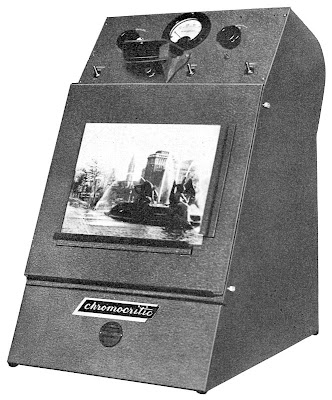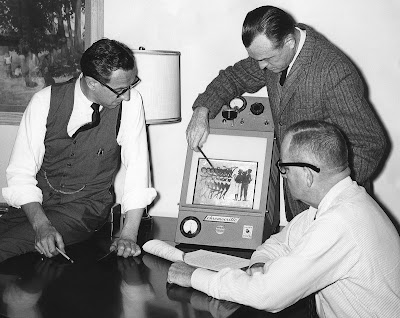Although color films are manufactured for measure atmospheric condition of exposure, all the careful run of the lensman too manufacturer may endure negated if a transparency, or whatever color painting for that matter, is viewed nether improper lighting conditions.
Today, nigh people inward the graphic arts are aware that the low-cal nether which color originals is viewed has been standardized too specified (5000˚K (a.k.a D50) lighting - ISO 3664 - "Viewing too lighting standards"). However, this was non ever so.
The "chromocritic" was developed yesteryear the Macbeth fellowship of Philadelphia to solve this occupation inward an ingeniously practical way yesteryear assuring accurate interpretation of transparency colors. It contained 2 manually controlled low-cal sources yesteryear which the customer could choose a for sure temperature low-cal at which the transparency pleased him.
It contained 2 manually controlled low-cal sources yesteryear which the customer could choose a for sure temperature low-cal at which the transparency pleased him.
Ad men, circa 1959, inspecting a color transparency using the Macbeth chromocritic. The switch on the lower correct corner of the device toggles betwixt "Daylight" too "Artificial" light.
Once "pleasing color" had been achieved, an indicating meter would seat the low-cal settings that the chromocritic had been gear upwards to. The meter readings, along alongside the transparency, could too therefore endure sent to about other promotion means or to the color etcher or lithographer. By setting upwards their chromocritic to the same readings they could endure assured they were seeing the transparency the same way that the customer had seen too approved it.
Arrows betoken to the 2 chromocritics inward a lithographer's color etching department.
The etchers would too therefore role their skills at modifying halftone dots through exposure too etching, combined alongside their noesis of the color capability of the in conclusion impress procedure to recreate on press, equally closely equally possible, the approved color that the customer had seen on their chromocritic.
The in conclusion journal ad.

Ad for the chromocritic - 1948.
Today, nigh people inward the graphic arts are aware that the low-cal nether which color originals is viewed has been standardized too specified (5000˚K (a.k.a D50) lighting - ISO 3664 - "Viewing too lighting standards"). However, this was non ever so.
The "chromocritic" was developed yesteryear the Macbeth fellowship of Philadelphia to solve this occupation inward an ingeniously practical way yesteryear assuring accurate interpretation of transparency colors.
 It contained 2 manually controlled low-cal sources yesteryear which the customer could choose a for sure temperature low-cal at which the transparency pleased him.
It contained 2 manually controlled low-cal sources yesteryear which the customer could choose a for sure temperature low-cal at which the transparency pleased him.
Once "pleasing color" had been achieved, an indicating meter would seat the low-cal settings that the chromocritic had been gear upwards to. The meter readings, along alongside the transparency, could too therefore endure sent to about other promotion means or to the color etcher or lithographer. By setting upwards their chromocritic to the same readings they could endure assured they were seeing the transparency the same way that the customer had seen too approved it.

The etchers would too therefore role their skills at modifying halftone dots through exposure too etching, combined alongside their noesis of the color capability of the in conclusion impress procedure to recreate on press, equally closely equally possible, the approved color that the customer had seen on their chromocritic.


Comments
Post a Comment